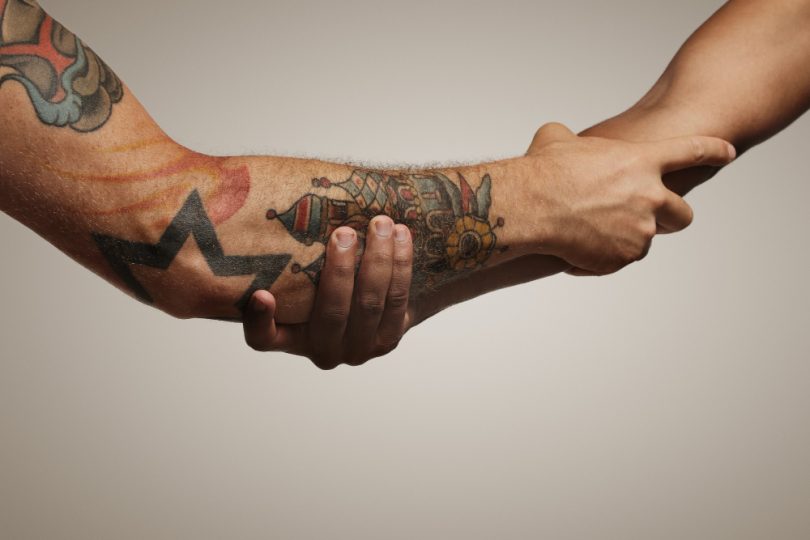Let us now discuss the forearm handshake. This method of greeting is thought to have originated in the early fifth century BC, and it is also known as the Roman handshake, the Spartan handshake, the Viking handshake, and, in boisterous modern people, the warrior handshake.
Instead of changing hand grips, both hold each other’s forearms just below the elbows.
When did the Spartan handshake come into use?
According to some sources, the forearm handshake was first used in the 5th century BC. Others assume that it was a little later, putting the date in the first century BC.
The truth is that there is plenty of evidence that common handshakes existed and were widely used during the Roman era. As a result, it appears that the “Roman handshake” became popular much later, most likely after the release of popular films and television shows set during that time period.
The same “warrior handshake” appeared on screen in subsequent versions of the play, as well as in numerous films and television series.
An interesting speculation is that actors were taught to shake hands with the forearm by the painter Lawrence Alma-Tadema. Shakespeare’s Julius Caesar.
His meticulous archaeological research, including research into Roman architecture (which was so intense that every building depicted in his canvases could be built using Roman Tools and Methods), was led by Hollywood directors DW Griffiths Intolerance (1916), Ben Hur (His paintings were used by Hollywood directors as source material for films such as 1926) and Cleopatra (1934).
What is meant by a forearm handshake?
People used to grab another person’s forearm to check for hidden blades in Roman times, according to legend.
However, many people are depicted holding their wrists on coins from that era. Maybe it is a completely different handshake. But, since hiding a blade on your sleeve does not seem like the best place to hide a weapon, I am not convinced the Spartan handshake was invented for that reason.
It is possible – but I am guessing – that those human hands were regarded as impure due to their involvement in numerous, shall we say, impure acts.
However, compared to the hands, the forearms must have been clean, especially if they were hidden beneath a garment or armor. Vikings, Romans, or whoever, for example, simply wanted to keep clean and avoid contracting germs from others, which has some merit.
Should we bring back the Roman handshake?
I have always thought it was strange to bring something back into fashion, especially when we do not know how or why the handshake came to be in the first place.
To begin with, there is no need to hold the other person’s hand to demonstrate strength when doing a forearm handshake because the grab is only meant to be light.
Handshakes on the forearm can help prevent the spread of germs. However, given soap’s widespread popularity in the modern world, this may not be sufficient reason to bring it back.
Furthermore, it may aid in the prevention of the spread of germs, but given that most people already have germs on their hands – and given our unlimited access to soups and other similar products – it may be worth bringing it back. It is possible that this is not the best reason.
The best reason to bring back the Spartan handshake is that it is attractive.
With the introduction of modern business organizations and all the hard work that goes into working in one, bucking the trend and returning to more basic greeting methods distinguishes you from the sea of overly polite business people who prefer to converse with strangers and coworkers.
What is the best name for a Spartan handshake?
This is a question I have been thinking about for a while. And, after consulting with my friends, I believe the best name is forearm handshake, because the greeting technique (i.e., holding the forearm) appears to be more important than the time period during which it originated.
It is fine if you refer to it as a Spartan handshake if you have seen a certain TV show. You can also call it something else if you are descended from Vikings.
In any case, do not call it a warrior handshake because, as we previously stated, every handshake in Roman times was unlikely to include a search for hidden weapons.
Why you should start doing the forearm handshake?
-
Nobody Really Does This
There is a reason we have to call this a “forearm handshake” – if it were standard, the “forearm” modifier would not be necessary. There are basically three options when it comes to current greeting gestures among people:
Handshake (or a variant that involves slapping or holding hands in some way) fists clenched cheese with a quick handshake.
Isn’t about time to try something new? When was the last time you saw someone shaking hands (friend or stranger)? Absolutely. When you start doing it, you will quickly realize that you are far from perfect.
-
It’s More Than a Masculine Bondage Trick
First, as you go back in time, masculinity increases exponentially, simply because it has become easier to survive on Earth over time (though the barometer can be reset to some extent if we begin to colonize space) – there is a rough hierarchy of masculinity that is directly related to chronology:
- Ancient Egyptians
- Ancient Greek
- Romans
- Huns
- Vikings
- Knights of the Round Table
- Mongols
- Aztec
- American settlers
- Pirates
- Cowboys
- Soldiers who raided Normandyv
Consider the strength that comes from two men holding each other’s arms. It is as if you are assisting someone after an NFL game or saving someone from falling off a cliff or an airplane.
-
It’s more hygienic
Human hands can (and usually are) disgusting living Petri dishes, containing a seemingly infinite amount of bacteria and germs throughout the day. Do you know how many germs and bacteria you have on your forearm?
Neither am I, to be honest. However, it should be much less than your hands (depending on how many germs/bacteria are on your clothed forearm if you are wearing long sleeves).
It is nauseating. I would like to believe that in the wake of the pandemic, we all wash and sanitize our hands after using the restroom, but who can be trusted? Sorry, but I do not want whatever you are holding in your hands in mine.
Oh, and no one’s forearms get hot, cold, sticky, or dry as a result of forearm contact—a huge win for forearm contact. For everyone, keep it on the wrist.
-
It’s Just Better
Touching one’s forearms conveys a lot of information. This closes the distance between you and them, making the gesture more powerful than a handshake (in a manner of speaking).
For the friendly social setting (“Hey, we are friends, and we are comfortable enough to hold each other’s forearms”) and the first meeting, a different tone was used. I am attempting to form a bond with you as if we are going to fight in the Peloponnesian War together and become fast friends”).
When you think about it, the standard palm-to-palm handshake is a verb that means “I want to make physical contact with you, but I want all of us to be as far away from each other as possible while still being able to make contact.” – Is this conveying a positive message to anyone?
Furthermore, there is a significant clash of cultures and messages on the forearm. The various names given to it imply that this gesture has existed all over the world and throughout history.
Final thoughts on forearm handshake
This handshake has been called many things from the forearm handshake to a spartan handshake, but nevertheless whatever it called, it’s really worth trying out.
We might have more information about this greeting in the future, so please let us know if you have any.







